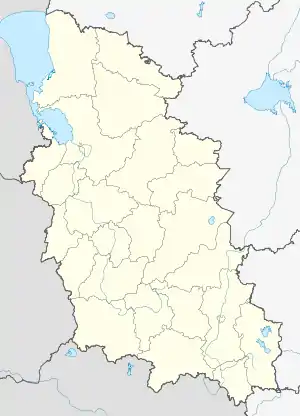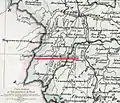Vyshgorodok
Vyshgorodok (Russian: Вышгородок; Latvian: Višgorodoka or Augšpils) is a selo (village) in Gavry volost, Pytalovsky District of Pskov Oblast, Russia, founded in the 15th century as a borderline fortress.
Vyshgorodok
Вышгородок | |
|---|---|
Village | |
Location of Vyshgorodok 
| |
 Vyshgorodok Location of Vyshgorodok  Vyshgorodok Vyshgorodok (Pskov Oblast) | |
| Coordinates: 57°01′57″N 28°00′10″E | |
| Country | Russia |
| Federal subject | Pskov Oblast |
| Administrative district | Pytalovsky District |
| Founded | 1476[1] |
| Population | |
| • Estimate (2000) | 534 |
| Time zone | UTC+3 (MSK |
| Postal code(s)[3] | 181420 |
| OKTMO ID | 58653410168 |
![]() Grand Duchy of Moscow 1510–1547
Grand Duchy of Moscow 1510–1547
![]() Tsardom of Russia 1547–1721
Tsardom of Russia 1547–1721
![]() Russian Empire 1721–1917
Russian Empire 1721–1917
![]() Russian Republic 1917
Russian Republic 1917
![]() Soviet Russia 1917–1920
Soviet Russia 1917–1920
![]() Latvian Republic 1920–1940
Latvian Republic 1920–1940
![]() Soviet Union 1940–1991
Soviet Union 1940–1991
History
Pskov Republic
During the 13th-15th century Pskov Republic was engaged in the bordeline conflicts with the Livonian Order, Archbishopric of Riga and the Great Duchy of Lithuania. One of these resulted from the Orderial claims for the territories west from the Krasny Gorodok. With the truce of 1476 Master of the Livonian Order Bernd von der Borch abandoned these claims.[4]
The inhabitants of the Kokshiono parish, however, requested the Veche (council) and the Prince of Pskov to secure the border with military means to save them from Livonian raids. In 1476 a wooden fortress was founded on the Lada river by two posadniks of Pskov - Alexey Vassilievich and Moisey Fyodorovich. Construction was completed in 1478.[1][5] It had limestone basement, two wooden watchtowers and gates on the edges facing Pskov and Livonia.[6] The Germans, in turn, maintained their bordeline castle of Marienhausen (now Viļaka) some 25 km. to the west (since 1294).
In 1479 Livonian knights attacked Vyshgorodok burning down the fortress and the church there, and killing the villagers. The next year 1480 Livonians repeated their raid. Pskov called Muscovy for help and in 1482 joint forces responded with intrusion into the Livonian lands.[7][8]
The fortress of Vyshgorodok was never restored, but the settlement developed and expanded into a town of Vyshgorodok, hosting the Pskovian garrison that watched after the border. The town was ruled by the vicegerent appointed from Pskov and was an administrative center of the county consisted of eight parishes: Borisoglebskaya, Grivskaya, Kokshinskaya, Lebetskaya, Korovskaya Ovsitskaya, Yolkinskaya and Kukhovskaya.[9][10]
G.D. of Moscow, Tsardom of Russia, Russian Empire and Russian SFR
In 1510 Pskov came under the rule of Muscovy.[11] Part of its aristocracy suspected for unloyalty was moved to Vyshgorodok. To watch after the border the town had to maintain a garrison of local militia on its own expense.[12]
In 1581 Polonian units led by the king Stephen Báthory advanced through Vyshdorodok to Pskov, but were unable to capture the city.
Late 17th century Vyshgorodok hosted two annual trade fairs. In 1690 it suffered from the fire that destroyed much of the housing along old Kowno road.[12]
During the Great Northern War, in 1708 Vyshgorodok listed in the newly established Saint Petersburg Governorate of the Russian Empire. In 1719 Vyshgorodok transferred to the Pskov Governorate. Despite its name (literally - town on the hill), on the maps and plans of XVIII Vyshgorodok listed as a village.[13]
In 1844 first municipal school was opened in Vyshgorodok, in 1897 another school opened by the church. In 1846 a hospital was founded by the Ministry of Interior. In 1911 a library run by the local teacher Olga Levkovich was opened. With the construction of Saint Petersburg–Warsaw Railway that had a station by the neighbouring village of Pytalovo the latter gradually becomes the main settlement of the county.[14]
After Nicholas II of Russia abdicated in 1917, the Soviets take control over most of the Pskovian municipalities, including Vyshgorodok. Peasants started seizing land plots from the local landlords.[15]
During the World War I and the Russian Civil War
As the Bolshevik Government fails to finalize the Treaty of Brest-Litovsk with the Central Powers, the latter resumed their advance eastwards on Pskov and Petrograd, so the village comes under the German rule until fall 1918 when the Red Army recaptures Vyshgorodok.[16]
In May 1919 г. Vyshgorodok appeared in the frontline of advancing pro-czarist Russian North-Western Army of Gen. Nikolai Yudenich supported by Estonian and Latvian republican units. The frontline as of noon 1 February 1920 was stipulated as the border demarcation line by the Latvian–Soviet Peace Treaty of 1920 between Latvian Republic and Russian Soviet Federative Socialist Republic, what left Vyshgorodok with Latvia.
Latvian Republic and Latvian SSR
From 1920 to 1924 Vyshgorodok belonged to Ludza county. In 1925 it was renamed to Augspils and included in to Pytalovo (1925-1938 Jaunlatgale, 1938-1944 Abrene) county that also contained other territories of the Pskov Governorate annexed to Latvia by the Treaty of 1920.
In 1927 the municipal school of Vyshgorodok was reconstructed to accommodate two schools - for Russian and Latvian speakers.[17]
In 1940 Soviet Union annexed Latvian Republic and established Latvian Soviet Socialist Republic (LSSR) within its existing borders as of 1920, so Vyshgorodok belonged to the Soviet Latvia.
From July 1941 till June 1944 Vyshgorodok appeared in the zone of Nazi occupation covered by the Reichskommissariat Ostland, Generalbezirk Lettland, Gebietskommissariat Dunaburg.
Russian SFR and Russian Federation
In January 1945 the border between Russian SFR and Latvian SSR was redrawn to resemble the historical border between the imperial Governorates of Pskov and Livland. Vyshgorodok appeared in the Pytalovo district of the Pskov oblast.[18] The district of Pytalovo was briefly (1959-1965) discontinued, leaving Vyshgorodok with the district of Ostrov.
Agrarian reform carried out during late 1940-ties - 1950-ties converted local private farming into a state-owned collective farm "sovkhoz Leninskiy" headquarteded in Vyshgorodok. It leased the required machinery from the MTS in Pytalovo up to the 1960-ties, as MTS system was abandoned and machines were distributed among local collective farms.
Soon after the USSR collapsed in 1991 the collective farm was privatized and later closed.[19]
Pustoshniki
During the second half of 19th - early 20th centuries western part of the Pskov Governorate including Vyshgorodok experiences major inbound migration from the Baltic provinces, where the serfdom was abandoned half a century earlier than across the rest of Russia. Latvian and Estonian peasantry that had no means to buy enough land from their landlords were forced to seek cheaper options available right across the Eastern border of the Governorate of Livonia.[20]
According to the 1911 statistical reference book for the Ostrov county of the Pskov Governorate, Vysgorodok parish accommodated 1.8 thousand immigrants that either purchased (pustoshniki) or leased plots of land, 300 of whom were from Livonia and Estonia.[21]
Facilities and transport
Now village hosts a School, a kindergarten,[22] post office and a paramedical office.
Vyshgorodok stands on the intersection of the road 58K-306 connecting Ostrov to the border with Latvia and roads to Pytalovo and Kokshino. Regular bus service to Ostrov, Pytalovo and Pskov is available.[23]
Boris and Gleb Church
Initially constructed in the 15th century it was destroyed by Livonian knights in 1479. In 1690 the Church was rebuilt as two adjacent loghouses. By the late 19th century it deteriorated and in 1891 new red brick church building was completed, having inherited the old altar. Funds to complete the construction of the church were given by Ostrovian landlord Vladimir Izyetdinov, and later by the Rukavishnikov family. The church has survived throughout the period of Latvian governance and during the communist rule.[24][25]
Gallery
 Vyshgorodok on the Pskov Governorate map, 1820
Vyshgorodok on the Pskov Governorate map, 1820 Russian Orthodox church in Vyshgorodok, Pskov Oblast'
Russian Orthodox church in Vyshgorodok, Pskov Oblast' Hillfort of Vyshgorodok and its posad
Hillfort of Vyshgorodok and its posad Westward view from the Vyshgorodok hillfort
Westward view from the Vyshgorodok hillfort A memorial stone of the Vyshgorodok hillfort that reads "An archeological monument - Vyshgorodok hillfort. Founded in 1476. During the XV-XVI centuries it was one of the fortification on the westernmost frontier of the Pskovian Land. Preserved by the Government."
A memorial stone of the Vyshgorodok hillfort that reads "An archeological monument - Vyshgorodok hillfort. Founded in 1476. During the XV-XVI centuries it was one of the fortification on the westernmost frontier of the Pskovian Land. Preserved by the Government."
References
- Savignac, David. "The Pskov 3rd Chronicle (translation)". pp. 174–175.
- "Об исчислении времени". Официальный интернет-портал правовой информации (in Russian). 3 June 2011. Retrieved 19 January 2019.
- Russian Post(in Russian)
- Feldbrugge, Ferdinand. Law in Medieval Russia.
- Харлашов, B.N. "Некотоые итоги изучения административно-территориального деления Псковской земли". Археология и история Пскова и Псковской земли - тезисы ежегодной научно-практической конференции.
- "The Pskov 3rd Chronicle".
- Martin, Janet (6 December 2007). Medieval Russia, 980-1584. Cambridge University Press. ISBN 9780521859165 – via Google Books.
- Baranov, Alexander (1 January 2013). ""Магистр Ливонского ордена Бернд фон дер Борх и Псковская земля в контексте ливонских внутриполитических отношений (1471-1474)" [The Master of the Livonian Order Bernd von der Borch and the Land of Pskov in the Context of Livonian Internal Political Relations (1471-1474)]". 58. Cite journal requires
|journal=(help) - "1711 год: Переписная книга Псковских пригородов - Генеалогия РУ".
- "История города Пыталово, Псковской области".
- Масленникова Н. Н. Присоединения Пскова к Русскому централизованному государству. Leningrad, 1955
- "Pytalovo Museum web-site".
- Памятная книжка Псковской губернии 1913—1914 гг. (1914psk.pdf)
- "Pytalovo Museum - Timeline of Pytalovo".
- http://krai-pskovsky.ru/gorod-pytalovo/6/
- "В годы первой Мировой войны | Официальный портал государственных органов Псковской области". www.pskov.ru. Retrieved 2016-05-19.
- "Немного истории :: Вышгородецкая школа".
- "Decree of the USSR Supreme Council Presidium of 23.08.1944".
- http://www.gcourts.ru%2Fcase%2F27923647&usg=AFQjCNG5Qn6vQDZAUmj79ntK4DIYGA39pQ&sig2=Q3JBOrePWhKrWts-58ijpQ
- Strods, H. НАЧАЛО ПЕРЕСЕЛЕНИЯ ЛАТЫШСКИХ КРЕСТЬЯН В РОССИЮ в 40-е — 60-е гг. XIX в. Riga.
- ПСКОВСКАЯ ГУБЕРНИЯ, Свод данных оцен.-статист. исследования, 1911, Том VI, Островской уезд. Pskov. pp. 70–74. Check date values in:
|date=(help) - "Pskov Oblast education reference book" (PDF).
- V.Skorykh. "Автовокзал Пыталово - расписание автобусов и цены на билеты".
- "Вышгородок, деревня Пыталовского района Псковской области".
- "Храм святых мучеников Бориса и Глеба, дервня Вышгородок - Официальный приходской сайт".
External links
- 1711 Census of the Russian towns, in Russian
- Pytalovo town, in Russian
- Rural settlements in Petersburg and Pskov Governorates in late XIX-early XX centuries, in Russian
- Archeological expedition in Pskov during 1945-1949, story by A.Filimonov, in Russian
- Overview of administrative division of the Pskovian land, by B.Kharlashov, in Russian
Псковское областное Собрание депутатов. Закон №420-оз от 28 февраля 2005 г. «Об установлении границ и статусе вновь образуемых муниципальных образований на территории Псковской области», в ред. Закона №1542-ОЗ от 5 июня 2015 г. «О внесении изменений в Закон Псковской области "Об установлении границ и статусе вновь образуемых муниципальных образований на территории Псковской области"». Вступил в силу со дня официального опубликования. Опубликован: "Псковская правда", №41–43, №44–46, №49–51, 4 марта 2005 г., 5 марта 2005 г., 11 марта 2005 г. (Pskov Oblast Council of Deputies. Law #420-oz of February 28, 2005 On Establishing the Borders and the Status of the Newly Formed Municipal Formations on the Territory of Pskov Oblast, as amended by the Law #1542-OZ of June 5, 2015 On Amending the Law of Pskov Oblast "On Establishing the Borders and the Status of the Newly Formed Municipal Formations on the Territory of Pskov Oblast". Effective as of the official publication date.). .